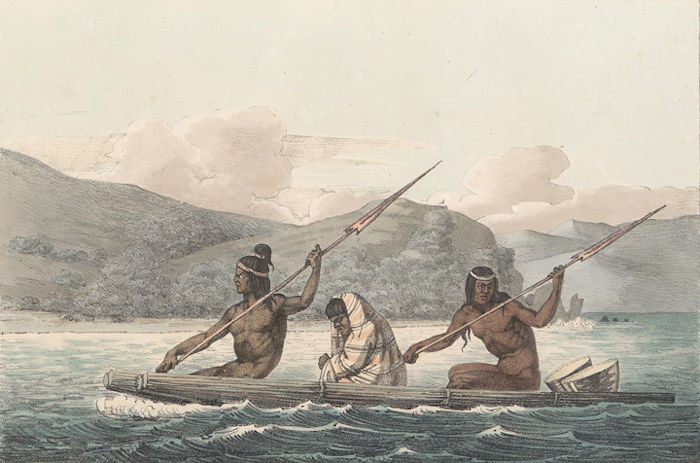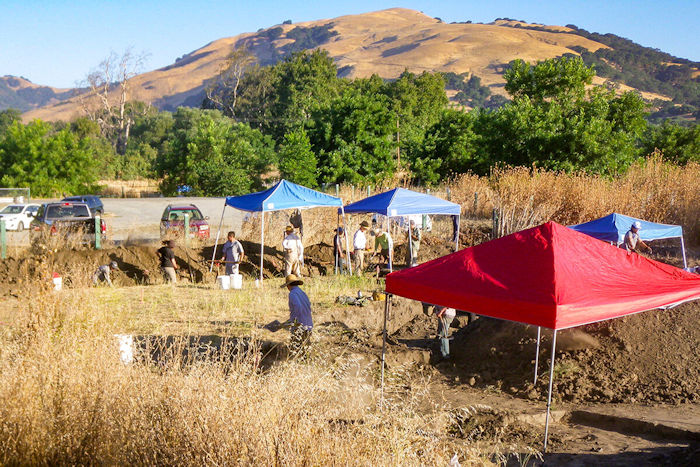Jan Bartek – AncientPages.com – A new DNA study challenges the notion that the Ohlone migrated to the San Francisco Bay Area between A.D. 500-1,000. Scientists who conducted a unique genomic study of Native peoples in the San Francisco Bay Area have discovered that eight present-day members of the Muwekma Ohlone Tribe share ancestry with 12 individuals who lived in the region several hundred to 2,000 years ago.

Ohlone Indians in a Tule Boat in the San Francisco Bay 1822, by Louis Choris. Credit: Public Domain
“We analyzed a large number of ancestral remains for DNA preservation and focused on those with the best DNA preservation for this study,” says Ripan Malhi, a professor of anthropology at the University of Illinois Urbana-Champaign, who led the research with Stanford University population genetics and society professor Noah Rosenberg in collaboration with a team of other scientists and members of the Muwekma Ohlone Tribe.
“We also worked with the Ohlone to sample saliva from present-day community members so we could compare the DNA from both groups.”
The study focused on nuclear DNA and sequenced near-complete genomes of several ancestral individuals, taking advantage of newer genome-sequencing approaches, Malhi said.
The team also compared ancient DNA from individuals who lived in California and other parts of North America to look for genomic similarities and differences between groups.
The ancestral individuals belonged to two villages near San Francisco Bay, one that persisted from about 490 B.C. to A.D. 1775, and the other that dated to A.D. 1345-1839. At the request of the Muwekma Ohlone Tribal Council, the Far Western Anthropological Research Group excavated both sites prior to large-scale infrastructure construction. Muwekma tribal members participated in all aspects of the fieldwork and were the primary excavators of all burials.
“This was a rare, collaborative, community-engaged research project, with tribal members and archaeologists working side by side for more than a year of fieldwork, resulting in a tremendous repatriation of knowledge to the descendent community,” said study co-author Brian Byrd, an archaeologist with the Far Western Anthropological Research Group in Davis, California.
The Tribal Council also requested and approved a study design for the genomics work, and members of the study team regularly met with the council and enrolled tribal members to review the work.
“Part of what we wanted to do is not just rely on the genomics but to have a more holistic approach of having community knowledge or traditional knowledge and genealogical information—along with all the archaeological documentation—to tell the story,” Malhi said.
Present-day enrolled members of the Muwekma Ohlone Tribe are directly descended from Native Americans who in the late 18th century through the mid-19th century were incorporated into the three Bay Area missions: San Francisco, Santa Clara and San Jose, the researchers reported. After the 1846-48 American conquest of California, the surviving Native American communities found safe havens on established “Californio rancho” lands held by individuals of Spanish, Mexican, Mestizo or Indigenous origins. They continued to be baptized at Mission San Jose and buried at the tribe’s Ohlone cemetery through the 1920s.
“Muwekma Ohlone comprise all the lineages who trace their ancestry through the Bay Area Missions of San Francisco, Santa Clara and San Jose, and who were also members of the historic previously federally recognized Verona Band of Alameda County,” the researchers wrote.
Using the mission’s baptismal, marriage and death records, the tribe traced its genealogical descent from the aboriginal village, districts and tribal groups surrounding the San Francisco Bay Area. The Muwekma Ohlone tribal leadership fully supported the ancient and modern DNA studies conducted on ancestors and present-day enrolled members.
Prior to European contact, the territory now known as California hosted one of the most populous and diverse Native American communities on the continent, the researchers wrote.

The excavation site. Credit: Far Western Anthropological Research Group
“At contact, more than 15,000 Native Americans from five distinct language groups were residing … within 20 kilometers of the bay,” they wrote. Studies of the Bay Area’s dense archaeological history reveal that “intensive sedentary or semi-sedentary habitation extends back more than 5,000 years” and the region’s archaeological record goes back more than 11,000 years.
The Native population was diverse, and European contact disrupted the existing communities, the researchers wrote. There were 21 Spanish missions established in California in the late 1700s and early 1800s, five of them in the Bay Area. Mexico claimed the territory in 1822, and in 1850 California became a U.S. state. A year later, the governor promised that “a war of extermination will continue to be waged between the races until the Indian race should become extinct.”
These upheavals led to population losses among the Muwekma Ohlone and other Native tribes, and admixture with Europeans. But a signature of the tribe’s ancient history remains embedded in the DNA of contemporary Ohlone community members, the researchers found.
See also: More Archaeology News
“We were able to find one ancestral component from their genomic analysis that was shared with ancient people from the Bay Area,” Rosenberg said. “The Ohlone living today who participated in the study may not be direct descendants of the ancient people whose genomes we sequenced, but the analysis suggests they descended from the broader population to which those ancient people belonged.”
The study was published in the Proceedings of the National Academy of Sciences.
Written by Jan Bartek – AncientPages.com Staff Writer





